Introduction
The continuous development of technology is changing the functioning of the world as we know it. This constant development makes digital products and services cheaper and more common. Some of them completely displace traditional products from the market. An example of this would be letters, most of which have been replaced by e-mail. In addition, the COVID-19 pandemic has shown how dependent we are on performing activities remotely, for which we need new digital technologies. At the time of the pandemic, in order to limit the transmission of the virus, many countries decided to introduce a lockdown and ban or limit movement. All social life, work, studies, entertainment, concerts, and theatre moved to the network. This would not be possible without the wide availability of the Internet, the use of digital equipment and digital competences.
Śledziewska and Włoch (2020) mentioned: “The development of technology is continuous. Already in 2018, more than five billion people – ⅔ of the world’s population – owned a wirelessly connected phone. Every third of these devices is a smartphone – a telephone, which is also a portable computer, whose computing power is a thousand times higher than that of the computer that in 1969 helped send people to the moon. The ubiquitous development and access to services and tools of the ICT sector has affected all areas of life. It shapes the current society, influences the economy and its development, changes culture and politics. (…) Today, digitalization is becoming widespread and global. As a result, the mode of production and consumption, the organization of the market under the influence of new business models, the nature of work and employment relations, the basic functions of the state and the way they are carried out are changing. Significant changes are also taking place at the global level.”
The aim of the study was to analyze the phenomenon of the impact of the development of the ICT sector on the economic growth rate of the European Union Member States in the years 2009–2018. To examine this relationship, macroeconomic data were used in the work, such as: the volume of exports of ICT goods expressed as a percentage of all exports of ICT goods, the volume of imports of ICT goods expressed as a percentage of all imports, the volume of exports of ICT services as a percentage of all exported services, employment in the ICT-related sector expressed as a percentage of total employment, percentage share of the ICT sector in GDP creation, the number of people shopping online per 100 inhabitants. The data were to be used to verify the main hypothesis and three auxiliary hypotheses.
The main hypothesis in the article indicates that the development of the ICT sector will always have a positive impact on the increase in the pace of economic development. The hypothesis seems to be consistent with most of the work created in the field of the development of digitization and its impact on GDP. In addition, the ubiquitous development of ICT in every area of life and at the same time the increase in the improvement of life strengthens this hypothesis. The other three hypotheses recorded in the paper are: the volume of online shopping among the inhabitants of the European Union Member States has a positive impact on economic growth; the increase in employment in the ICT sector has a positive effect on GDP growth; the export and import of ICT goods has a positive impact on economic growth.
In order to verify the hypotheses put forward in the article, a thorough econometric analysis was carried out. Initially based on the least squares model for panel data, a random effect (RE) model and a fixed effect (FE) model were used. Finally, a panel dynamic model of the Instrumental Variable Method was used, on the basis of which hypotheses were verified and conclusions were drawn.
Research Review
The role of ICT in the economy is the subject of interest of many scientific publications and reports of companies related to the digital industry. The key role of the ICT sector has long been recognized. As shown in the literature review, most scientists emphasize that it is currently the most important source of development and economic growth. Publications and reports most often deal with the relationship between the ICT sector and the efficiency of companies, economic growth, and development of the information society. Below are presented empirical studies that look at the impact of the digital economy on economic growth.
In the publication ICT growth effects at the industry level: a comparison between the US and the EU, Dimmelis and Papaioannou (2011) examine the impact of the ICT sector on production volumes between 1980 and 2000 in the European Union and the United States. They use panel data and the Generalized Moment Method estimator. The results clearly indicate the positive impact of the development of the ICT sector on GDP growth in both the United States and the European Union. They also found a leap in influence, which had the greatest strength in the early ‘90s of the twentieth century.
The next article, Telecommunications and economic growth: a panel data approach, by Datta and Agarwal (2004) also presents a panel method for conducting an empirical study of how telecommunications affect economic growth. The analysis was carried out for 22 OECD countries between 1980 and 1992. In the article, the ICT sector is presented in a more traditional way than today. The following were selected as variables for the panel model: the number of telephone lines per 100 inhabitants and additionally a square of this size. In the model, both variables were statistically significant. The first variable showed a positive effect of the number of telephone lines per 100 inhabitants on GDP growth, while the square of this size turned out to be negatively correlated with the increase in the value of Gross Domestic Product.
Pradhan, Arvin, Norman and Bele, in their article Economic growth and the development of telecommunications infrastructure in the G-20 countries: A panel-VAR approach published in 2014 using a panel model, calculated the impact of the ICT sector on economic growth for the G-20 countries in the period from 1991 to 2012. The following variables were selected as ICT sector variables: the number of mobile phones per 1000 inhabitants, the number of Internet users per 1000 inhabitants and the number of telephone lines per 1000 inhabitants. The authors of the article using Granger’s causality test showed a significant relationship between the ICT sector and its impact on economic growth. They pointed out that, in order to achieve long-term economic growth, it is necessary to focus on investments and development of the ICT sector.
The analysis of the impact of the ICT sector on economic growth for as many as 128 countries was carried out by Jin and Cho in their article Is ICT a new essential for national economic growth in an information society?, published in 2015. The survey was conducted using the following variables: the number of people with access to broadband Internet, the number of people with a fixed computer, the number of telephone subscriptions per 100 inhabitants, the volume of exports and imports of goods from the ICT sector, the number of people employed in the ICT sector in relation to the entire population of the country, the size of investment in the ICT sector, profits of the ICT sector and expenditure on equipment. According to research, to varying degrees, all variables affect GDP growth in all surveyed countries. The analysis was based on data from 1999–2012.
In the article Information and Communication Technology Use and Economic Growth by Farhadi, Ismail, Fooladi, published in 2012, an analysis of the impact of the ICT sector on GDP growth was carried out. The authors used a dynamic panel model that uses data for the years 2000–2009 for 159 countries. The results presented in the paper show that there is a positive relationship between the growth rate of the Gross Domestic Product and the size and level of use of the ICT sector, which was expressed at work as the number of Internet users, the number of people with access to broadband Internet, the number of mobile subscriptions per 100 inhabitants. An additional conclusion in the paper was the statement that the impact of the use of information and communication technologies on economic growth is greater in the group of richer countries than in countries that are classified as poorer countries. The authors stressed the important role of legal regulations to facilitate the use of information and communication technologies.
An important article that examined the impact and quality of the impact of the ICT sector on economic growth is the article The productivity paradox: A meta-analysis by Polak (2017). The author used a meta-analysis, which was based on a set of over 800 estimates of the benefits associated with the ICT sector from over 70 studies written over the last 20 years. A meta-analysis revealed a strong presence of publication bias in the literature on ICT productivity. After analyzing the results, the author concludes that the development of the ICT sector does not affect GDP growth as significantly as many researchers describe. Using a multi-level mixed-effect model, it estimates the flexibility of ICT at just 0.3%, which is more than ten times less than what was reported in the previous meta-analysis, which was conducted 10 years earlier.
ICT Sector in EU Countries
Different Member States face different levels of economic development. Although the European Union strives to make the Member States equal in terms of development, each of the EU countries bases its economy on a different part of the economic sector. The European Commission encourages Member States to invest in the economy, developing its innovativeness; in particular, the development of the ICT sector.
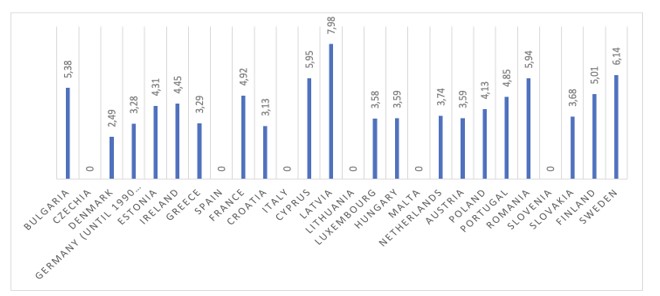
Fig. 1. Percentage share of the ICT sector in GDP in 2018 in the Member States of the European Union
Source: Author’s own elaboration based on Eurostat data
Figure 1 shows the percentage share of the information technology sector in GDP in 2018 in the European Union member states. Data were missing for the Czech Republic, Spain, Italy, Lithuania, Malta and Slovenia. The lowest share of the ICT sector in GDP is in Denmark and Germany. However, it must be taken into account that these are large and strong European economies in which the ICT sector is well developed. The highest value of the share of the digital sector in GDP can be boasted by Latvia and Sweden. The average for the entire European Union was 4.47%. Data from Eurostat.
Another aspect that testifies to the development of the digital sector in the European Union is employment in the ICT industry. Below is a graph of the percentage of employment of the entire population in the digital economy sector in 2018 based on data collected from Eurostat (Figure 2). For Ireland, Cyprus, Luxembourg, the Netherlands and Portugal were not given data. The largest percentage of the total population working in the ICT sector works in Malta and Sweden. The lowest levels of employment can be observed in Greece and Italy.
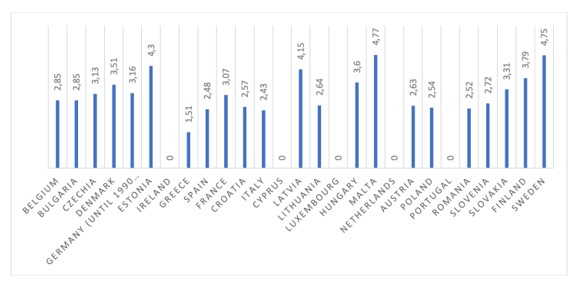
Fig. 2. Share of employment in the ICT sector in total employment (in %)
Source: Author’s own elaboration based on Eurostat data
Eurostat also conducts research on the digital competences of European Union citizens. Below is a graph of digital competences based on Eurostat data from 2019 (Figure 3), which shows how many people out of 100 surveyed had basic and higher digital competences in 2019.
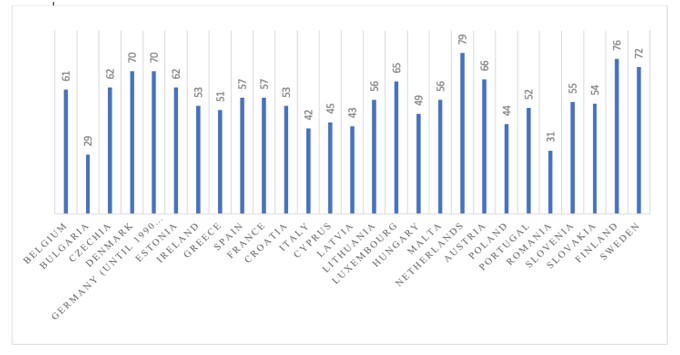
Fig. 3. Digital competences of citizens of the Member States in the EU in 2019.
Source: Author’s own elaboration based on Eurostat data.
The graph shows the percentage share of citizens with basic or higher digital competences. The countries with the highest digital competence ratios are the Netherlands, Finland, and Sweden. The countries with the least developed economic competences are Bulgaria and Romania. Digital competences affect the speed of development of the ICT sector. New services are being created and there is a demand for new goods based on digital technology. The development of the digital society and competences is a matter for the state. Trainings financed from the EU budget are conducted in the Member States of the European Union to improve their digital competences.
Figure 3 shows how diverse the Member States of the European Union are in many digital aspects. Each economy and society is different in terms of digital development, and, although all countries invest in the development of the ICT sector, it is not yet evenly developed throughout the European Union.
Description of Data
The study collected annual data from the period 2009–2018 for all Member States of the European Union. Data were collected from Eurostat and the World Bank. In the model, economic growth is explained by variables such as: the volume of exports of ICT goods expressed as a percentage of all exports of ICT goods, the volume of imports of ICT goods expressed as a percentage of all imports, the volume of exports of services as a percentage of all exported services, employment in the ICT-related sector expressed as a percentage of total employment (the ICT sector consists of people who have broad digital competences, such as IT specialists, but also employed in the production of ICT products such as technicians repairing and assembling digital equipment), the percentage of the ICT sector in the creation of GDP, the number of people using online shopping per 100 inhabitants. The data create an almost balanced panel because few values are missing from the entire panel. All variables, their data source and the units in which they are expressed, are listed in the table below:
Table 2: Data source
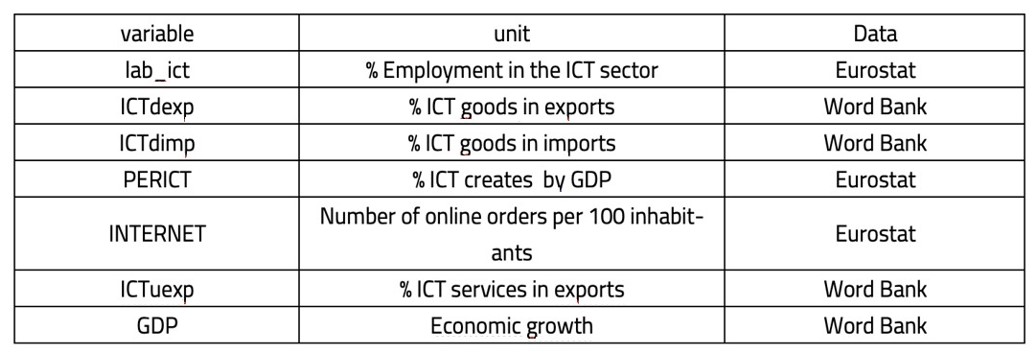
Hypotheses
Analyzing the available literature on the subject and referring to econometric and macroeconomic theories, it was decided to examine the hypotheses put forward in the article by conducting an extended econometric analysis using the NMK model for panel data, then extending the estimation with a random effects model (RE) and a fixed effects model (FE). The last model that completes the process of translating the hypotheses presented in the article is the Instrumental Variables Method, which is the main part of the study carried out in the article.
After extensive research of the literature and available scientific articles as well as empirical analysis, the following hypotheses were put forward in the article:
H0: The broadly understood ICT sector always has a positive impact on the growth of the Gross Domestic Product of the European Union countries;
H1: The volume of online shopping among the inhabitants of the Member States of the European Union has a positive impact on economic growth;
H2: Employment growth in the ICT sector has a positive impact on the growth of Gross Domestic Product;
H3: Exports and imports of ICT goods have a positive impact on economic growth.
Results
The table below shows the results for all models carried out in the article. The materiality level was set at 10% α%.
Table 2: Estimation results
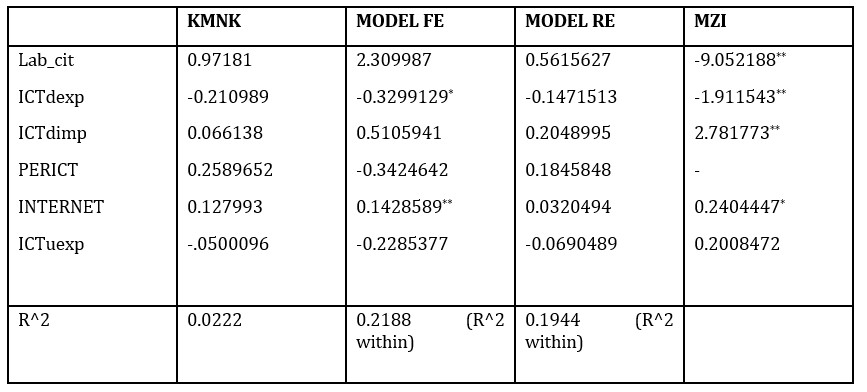 * – significant at the significance level α = 0.1
* – significant at the significance level α = 0.1
** – significant at the significance level α = 0.05
– significant at the significance level α = 0.01
No asterisk means that the variable is not important.
The first study was the choice of the NMK method. The results of the regression are presented in Table 2. After the study, all variables were found to be negligible at each significance level, therefore the results were not interpreted.
Then the solid effects model (FE) and the variable effects model (FE) were made.
Only two parameters were relevant in the study. The ICT sector export variable turned out to be significant at the materiality level of 0.1. The second variable in the model that was important was the Internet, which was already significant at the significance level of 0.05. An increase in exports of goods from the ICT sector by one percentage point is the growth rate of Gross Domestic Product that decreases by 0.33 percentage points. The model shows that when the level of online orders increases by 1 percentage point, the economic growth rate increases by an average of 0.2 percentage points. The rest of the variables in the model turned out to be irrelevant.
An increase in online orders can affect Gross Domestic Product by increasing consumption. A greater number of orders result in an increase in production, and thus an increase in employment.
Exports have a negative impact on GDP growth, which may be caused by the balance of foreign trade, but it is not known at what level imports are to be able to explain the volume of net exports.
The article also carried out estimation using a model with random effects. The estimation shows that all variables turned out to be irrelevant at each significance level. Therefore, no interpretation of the results was undertaken.
The last model made in the article was a dynamic model, which will be used to interpret the hypotheses put forward in the article. The method of Instrumental variables turned out to be the best, because the variables are interdependent, and MZI allows you to bypass this problem.
At the materiality level of α = 10%, the variables turned out to be important: the volume of exports and imports of goods from the ICT sector, the volume of online purchases, employment in the ICT sector. The only non-relevant variable in the model turned out to be the export of ICT sector services. The ERICT variable was chosen as the instrumental variable, which shows the percentage share of the ICT sector in the total Gross Domestic Product and which affects the variable GDP.
At a materiality level of α = 5%, the following variables proved to be relevant: exports and imports of ICT goods and employment in the ICT sector.
The MZI model shows that, with the increase in exports of goods from the ICT sector by 1 percentage point, the growth of Gross Domestic Product by 1.91 percentage points decreases. On the other hand, an increase of 1 percentage point in imports of goods from the ICT sector has a positive impact on economic growth of 2.78 percentage points. Employment in the ICT sector also has a negative impact on the growth of Gross Domestic Product, whose increase by 1 percentage point causes a decrease in the growth rate by 9.05 percentage points. Of the important variables in the model, only an increase in online orders by one percentage point results in an increase in Gross Domestic Product by 0.24 percentage points.
Hypothesis Verification and Conclusions
The main hypothesis put forward in the article, which said that the growth of the ICT sector always has a positive effect on the growth of the Gross Domestic Product, turned out to be wrong. The data show that the increase in employment in the ICT industry causes a decrease in the GDP growth rate. GDP growth is also negatively affected by exports of goods from the ICT sector.
The paper also contains three auxiliary theses, of which only one turned out to be true. Only the thesis about the positive impact of online procurement on GDP growth was positively verified. The MZI model empirically confirmed the positive impact of the increase in the volume of orders on the Gross Domestic Product. An increase in online orders means an increase in consumption, a component that is directly in the GDP equation.
The two hypotheses that have been verified negatively are those concerning employment in the ICT sector. The hypothesis put forward in the paper was to verify whether the increase in employment in the ICT industry has a positive impact on economic growth.
Using the Instrumental Variable Method, it was shown that, in the European Union countries, the increase in employment in the ICT industry affects the decline in the economic growth rate. The reason for this may be the way employment in the ICT industry is measured. The data refer to broadly understood work in this sector; these are IT specialists, IT technicians, production people in the production of digital equipment. The salaries of IT specialists are one of the highest salaries on the labor market. However, to become an IT specialist you have to incur very high costs. In addition, the group of employees in the ICT sector includes people with average and average salaries; these are people such as IT technicians, people repairing and manufacturing ICT equipment. An increase in employment in these occupational groups does not necessarily mean an increase in economic pace.
The last hypothesis that the export and import of ICT goods has a positive impact on the rate of economic growth has been verified negatively. Using the Instrumental Variable Method, it was shown that the export of goods from the ICT sector reduces the growth rate of the Gross Domestic Product, while the import of these goods has a positive impact on economic growth. Imports of ICT goods are greater than exports in the European Union, which may cause the balance of trade of ICT sector goods to be negative, which causes a slowdown in the growth rate of Gross Domestic Product.
However, when verifying the hypothesis of a positive impact of the ICT sector on economic growth, attention should be paid to the fact raised in the first chapter. The ICT industry operates on many levels; it still has components that are difficult for economists to measure and calculate, and which directly and indirectly affect the social, economic and cultural life of today’s world. This may lead to the conclusion that there are ICT sectors that currently do not directly affect economic growth, but are necessary for the development of the digital economy and will only have a positive impact on GDP later. Even in the short term, it can be said that some components of the ICT sector, even if they do not have a direct positive impact on the Gross Domestic Product, allow other components that positively affect GDP for development. Examples include employment in the ICT sector and the volume of purchases on the Internet. An empirical study shows that an increase in employment in the ICT industry has a negative impact on economic growth, while an increase in online shopping has a positive effect. However, without ICT workers to provide equipment, infrastructure and services, there will be no growth in online purchases.
On this basis, it can be said that the study simply verified hypotheses, but attention should be paid to the complexity of the problem and verified at a more advanced level, which would take into account the links between all factors of the ICT sector.
The article, contrary to many scientific articles and presented reports, shows that the broadly understood ICT sector is not automatically and immediately a driver of economic growth. One can wonder about the effects more spread over time – perhaps positive effects appear after many years. The work is the beginning of a broader discussion in which the impact of the entire ICT sector on GDP should be determined, in which more data and variables should be used, but which are currently difficult to access. It should also be considered whether it is worth developing every sector in the entire ICT industry or focusing on the most important for economic development.
The article is the beginning of a further discussion on the impact of the ICT sector on economic growth, which can be extended with new macroeconomic variables. Moreover, it seems interesting to examine the impact of the COVID-19 pandemic, which in many enterprises forced the use of digital solutions not previously used or significantly increased their scale, as well as to take into account the human factor, which is ignored in the work on the development of the ICT sector and its impact on the economy.
Bibliography
- Blanchard, O. (2017) Makroekonomia, Nieoczywiste, Warszawa.
- Datta, A. and Agarwal, S. (2004), ‘Telecommunications and economic growth: a panel data approach,’ Eastern Economic Association, 36 (15), 1649–1654 [Online], [Retrieved May 12, 2021],
- https://doi.org/10.1080/0003684042000218552
- Digital Economy and Society Index (DESI) 2020. [Online], [Retrieved December 13, 2021], https://digital-strategy.ec.europa.eu/pl/node/924
- Dimmelis, P. and Papaioannou, K. (2011), ‘ICT growth effects at the industry level: A comparison between the US and the EU,’ Information Economics and Policy, 23 (1), 37–50. [Online], [Retrieved May 13, 2021], https://doi.org/10.1016/j.infoecopol.2010.03.004
- Farhadi, M., Ismail, R., Fooladi, M. (2012), ’Information and Communication Technology Use and Economic Growth,’ PLoS ONE, 7 (11). [Online], [Retrieved May 12, 2021], https://doi.org/10.1371/journal.pone.0048903
- Gruszczyński, M. et al. (2012) Mikroekonometria. Modele i metody analizy danych indywidualnych, Wolters Kluwer Polska, Warszawa.
- Jabłoński, Ł. (2008), ‘Ewolucja poglądów na temat konwergencji w ekonomii rozwoju,’ Gospodarka Narodowa 5–6, 25–46. [Online], [Retrieved May 13, 2021], http://bazekon.icm.edu.pl/bazekon/element/bwmeta1.element.ekon-element-000151751612
- Jin, S. and Cho, Ch. (2015), ‘Is ICT a new essential for national economic growth in an information society?’. Government Information Quarterly, 32 (3). [Online], [Retrieved December 22, 2021], DOI:10.1016/j.giq.2015.04.007
- Malaga, K. (2009), ‘O niektórych dylematach teorii wzrostu gospodarczego i ekonomii,’ Polskie Towarzystwo Ekonomiczne, [Online], [Retrieved July 4, 2021], https://archiwum.pte.pl/pliki/2/12/k.%20malaga.pdf
- Mycielski, J. (2010), Ekonometria, Wydział Nauk Ekonomicznych Uniwesytetu Warszawskiego, Warszawa.
- Piętak, Ł. (2016), ‘Zrównoważony wzrost gospodarczy w teoriach i modelach wzrostu i rozwoju gospodarczego,’ Gospodarka w Praktyce i Teorii, 2(2(43)), 51–77. [Online], [Retrieved July 3, 2021],
- DOI:10.18778/1429-3730.43.04
- Polak, P. (2017), ‘The productivity paradox: A meta-analysis,’ Information Economics and Policy 38, 38–54. [Online], [Retrieved July 5, 2021], https://doi.org/10.1016/j.infoecopol.2016.11.003
- Pradhan, R. P., Arvin, M., Norman, N. R., and Bele, S. K. (2014), ‘Economic growth and the development of telecommunications infrastructure in the G-20 countries: A panel-VAR approach,’ Telecommunications Policy, 38 (7), 634-649. [Online], [Retrieved May 14, 2021], DOI: 10.1016/j.telpol.2014.03.001
- Schumpeter, J. A. (1934), The Theory of Economic Development, Harvard University Press, Cambridge.
- Sylwestrzak, M. (2018), ‘Wpływ ICT na wzrost gospodarczy w krajach Unii Europejskiej w latach 2006–2016,’ Ekonomiczne Problemy Usług, 131 (1), 361–369. [Online], [Retrieved July 4, 2021], DOI: 10.18276/epu.2018.131/1-35
- Śledziewska, K. and Włoch, R. (2020), Gospodarka cyfrowa. Jak nowe technologie zmieniają świat, Wydawnictwa Uniwersytetu Warszawskiego, Warszawa.
- Toader E., Firtescu, B. N., Roman, A., and Anton, S. G. (2018), ‘Impact of Information and Communication Technology Infrastructure on Economic Growth: An Empirical Assessment for the EU Countries,’ Resilient Infrastructure Systems and Sustainable Economic Growth, 10 (10), 3750; [Online], [Retrieved July 2, 2021], https://doi.org/10.3390/su10103750
- Wójcik, P. (2018), Metody pomiaru realnej konwergencji gospodarczej w ujęciu regionalnym i lokalnym. Konwergencja równoległa, Wydawnictwa Uniwersytetu Warszawskiego, Warszawa.







